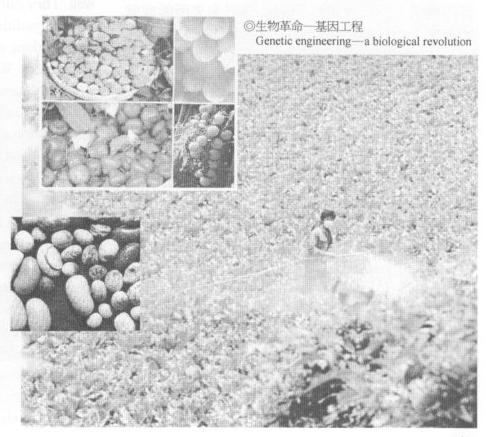簡介
在蘇聯政權徹底瓦解之前,我們無日不面對毀滅人類和整個生物圈的核子屠殺的威脅。如今全面性的毀滅似可避免;然而,核子電廠輻射外洩、陳舊的核子潛艇、某些政權或恐怖份子局部動用戰略性核子武器,所造成廣泛的破壞,雖然不再是全面性的,致命性的,但仍可能繼續發生。
一直為大多數人所忽略的,是基因工程對地球上的生命所帶來的空前致命性的威脅。除非國際政策能及早作出重大改革,否則維持生物圈的各個主要生態系統,將遭到無法挽救的破壞,而經由基因工程改造的濾過性病毒,極可能將人類領上滅絕的命運。在這些重大變化發生的過程中,人類本身也將在有意或無意間遭到改變,而在多方面都將與我們目前所認知的「人類」迥然不同。
我們罔顧危險,幾乎在一切的領域上全力衝刺。多間最強人的跨國化學、醫藥及農產品企業的經濟前途都把賭注押在於基因工程上。在投注了龐大的資金之後,美國政府如今以恐嚇的方式,要脅全世界迅速接受大型企業在基因工程研究和市場行銷方向的要求。
何謂基因工程
何謂基因?
基因時常被形容為人體及一切生物的「藍圖」或「電腦程式」。眾所週知,基因是按特定次序排列的脫氧核醣核酸DNA(deoxyribonucleic acid),它在蛋白質的製造中起著重要的作用,然而與一般人的認知及過時的標準基因模型相反的是,基因並不直接決定生物的「特質」,它們只是多種決定因素之一。(注la)它們提供「成份表」,交由生物的「機能系統」進一步組合。「機能系統」決定此生物未來如何發育。換言之,在多數情況下,某個單一的基因,並不全然決定我們身體上某一特徵、或行為上某一特質。一道菜的風味不單取決於食譜;還得看廚師如何抓菜和炒菜。同理,基因也經由生物自我組織「機能系統」的處理,作複雜組合,在種種環境因素的影響下,而產生身體或行為上的結果 。(註2)
附注:
1.易象乾博士是加州柏克萊法界宗教研究院的研究教授,舊金山州立大學哲學系講師。電郵地址:namofo@jps.net。有關本文進一步的資料,請參閱其網址http://online.sfsu.edu/~rone/gedanger.htm的「基因工程及其危險」一文。
1a.何(Ho譯音)等作者,總結新舊基因模型如下。在舊有的標準或稱為「中央定論」的模型中:
(a)在線性因果鏈中,基因決定特質,一個基因決定一個特質;
(b)不受環境影響:
(c)保持穩定及恆常。
(d)維持在生物體內,停留在原有的地方。
根據新的基因學:
(a)單獨起作用,是絕沒有的,任何一個都是處於一個極其複雜的基因網絡中,倚賴於基因集中所有其他基因的相互關係而起作用。因此,由於其他基因的差異,同一個基因對不同的人有不同的影響。人類的基因千差萬別,所以從基因上來說,每個人都是獨一無二的。並且,特別當基因轉移到另一個不同的品種時,很可能產生全新而無法預料的後果。
(b)網絡亦循序受到生物體的生理機能,以及它與外界環境關係的反饋調節的層層支配。
(c)這些層層的反饋調節不僅改變基因的作用,並將它們重新排列,大批複製、變更次序,或者移位。
(d)甚至可以遊移於原來的生物體之外,而感染其他生物——稱為橫向基因轉移。
(何梅文「Mae-Wan Ho譯音」、賀莫•梅爾「Hartmut Meyer」與傑•康敏斯「Joe Cummins」和著「生化科技泡沫」,登載於一九九八年五/六月刊、第28冊、第3期,《生態家》第一四八頁。)
2.史都華•紐曼(StewartA.Newman)著,登載於一九八九年九╱十月份《科學與自然》的「基因工程之為形而上學(metaphysics?)與威脅」一文,重點在第—一四至—一八頁。亦參考理查•思卓曼(RichardC Strohman)所著、登載於一九九七年三月第十五冊《自然生物科學》第一九四至二00頁,「漸成說與複雜性:下一波的生物庫恩(Kuhnian*)革命」一文。另見何梅文「Mae-Wan Ho譯音」所著,英國拜思(Bath)市「門道圖書出版社」一九九八年出版的《基因工程:美夢抑或噩夢。拙劣科學與財閥企業的勇敢新世界》。)【*註:指美國哲學家兼科學家湯瑪斯?庫恩(Thomas S.Kuhn),其著作包括《科學革命之結構》。】
待續
|
|
INTRODUCTION
Until the demise of the Soviet Union, we lived under the daily threat of nuclear holocaust extinguishing human life and the entire biosphere. Now it looks more likely that total destruction will be averted, and that widespread, but not universally fatal, damage will continue to occur from radiation accidents from power plants, aging nuclear submarines, and perhaps the limited use of tactical nuclear weapons by governments or terrorists.
What has gone largely unnoticed is the unprecedented lethal threat of genetic engineering to life on the planet. It now seems likely, unless a major shift in international policy occurs quickly, that the major ecosystems that support the biosphere are going to be irreversibly disrupted, and that genetically engineered viruses may very well lead to the eventual demise of almost all human life. In the course of the major transformations that are on the way, human beings will be transformed, both intentionally and unintentionally, in ways that will make us something different than what we now consider human.
Heedless of the dangers, we are rushing full speed ahead on almost all fronts. Some of the most powerful multinational chemical, pharmaceutical and agricultural corporations have staked their financial futures on genetic engineering. Enormous amounts of money are already involved, and the United States government is currently bullying the rest of the world into rapid acceptance of corporate demands concerning genetic engineering research and marketing.
WHAT IS GENETIC ENGINEERING
What are genes?
Genes are often described as 'blueprints' or 'computer programs' for our bodies and all living organisms. Although it is true that genes are specific sequences of DNA (deoxyribonucleic acid) that are central to the production of proteins, contrary to popular belief and the now outmoded standard genetic model, genes do not directly determine the 'traits' of an organism.1a They are a single factor among many. They provide the 'list of ingredients' which is then organized by the 'dynamical system' of the organism. That 'dynamical system' determines how the organism is going to develop. In other words, a single gene does not, in most cases, exclusively determine either a single feature of our bodies or a single aspect of our behavior. A recipe of ingredients alone does not create a dish of food. A chef must take those ingredients and subject them to complex processes which will determine whether the outcome is mediocre or of gourmet quality So too the genes are processed through the self-organizing ('dynamical') system of the organism, so that the combination of a complex combination of genes is subjected to a variety of environmental factors which lead to the final results, whether somatic or behavioral.2
Notes: 1. Ron Epstein is Research Professor at the Institute for World Religions, Berkeley, CA, and Lecturer, Philosophy Department, San Francisco State University. His email address is namofo@jps. net. Further information related to the present article is available on his website "Genetic Engineering and Its Dangers" <http:// online.sfsu.edu/ ~rone/gedanger.htm>. la. Ho et. al. summarize the old and new genetic models as follows. In the old standard or 'central dogma' model:
(a) Genes determine characters in linear causal chains, one gene giving rise to one character;
(b) Genes are not subject to influence from the environment;
(c) Genes remain stable and constant;
(d) Genes remain in organisms and stay where they are put.
According to the new genetics:
(a)No gene ever works in isolation, but rather in an extremely complicated genetic network. The function of each gene is dependent on the context of all the other genes in the genome. So, the same gene will have very different effects from individual to individual, because other genes are different. There is so much genetic diversity within the human population that each individual is genetically unique. And, especially if the gene is transferred to another species, it is most likely to have new and unpredictable effects.
(b)The genetic network, in turn, is subject to layers of feedback regulation from the physiology of the organism and its relationship to the external environment.
(c) These layers of feedback regulation not only change the function of genes but can rearrange them, multiply copies of them, mutate them to order, or make them move around.
(d)And, genes can even travel outside the original organism to infect another— this is called horizontal gene transfer.
(Mae-Wan Ho, Hartmut Meyer and Joe Cummins, "The Biotechnology Bubble" Ecologist 28(3) May/June 1998, p. 148.
2. Stewart A. Newman, "Genetic Engineering as Metaphysics and Menace," Science and Nature 9/10 (1989): esp. 114-118. See also Richard C Strohman "Epigenesis and Complexity: the Coming Kuhnian Revolution in Biology," Nature Biotechnology 15 (March 1997): 194-200, and Mae-Wan Ho, Genetic Engineering: Dream or Nightmare. The Brave New World of Bad Science and Big Business (Bath, UK: Gateway Books, 1998).
To be continued

|